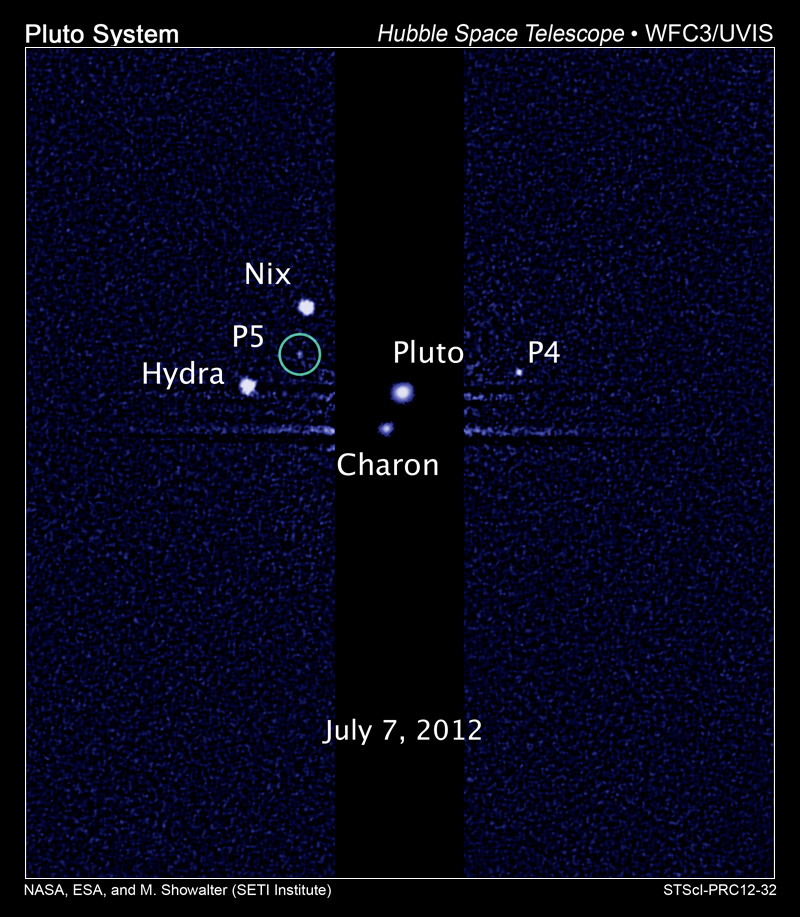Let's Name Pluto Moons 'Vulcan' and 'Romulus,' William Shatner Says

Astronomers put out the call this week for cosmic names worthy of the two unnamed moons of Pluto, and Captain James T. Kirk has answered. Famed actor William Shatner, who portrayed the iconic "Star Trek" starship captain, wants to call them "Vulcan" and "Romulus."
Pluto has five moons but only three of them — Charon, Nix and Hydra — have names. The most recently discovered moons are known by the rather drab names P4 and P5. The two tiny moons are only 15 to 20 miles (20 to 30 kilometers) wide. Pluto and its three named moons are all named for Greek and Roman characters related to the underworld, and scientists are hoping to continue that tradition for the two newest moons.
But Shatner thinks the astronomers running the vote at the SETI Instituteoverlooked a couple important possible monikers for the moons.
On Monday (Feb. 11), Shatner used his Twitter page to suggest that "Vulcan" and "Romulus" be added to the list of 12 names already in contention. While both of those names are pulled directly from the "Star Trek" universe (the home planets of the Vulcan and Romulan alien races) they also have some basis in mythology. [See photos of Pluto and its moons]
Vulcan is the Roman god of fire and lava and Romulus is a twin brother to Remus in the Roman foundation myth.
Astronomers running the Pluto moon naming campaign accepted Vulcan, adding it to the list a day after Shatner suggested it, but Romulus didn't make the cut.
"Mr. Shatner's second suggestion, Romulus, has a bit of a problem because it is already the name of a moon," Mark Showalter, an astronomer involved with the competition, wrote in a blog on the Pluto Rocks website on Tuesday. "Romulus, along with his brother Remus, are the names of the moons of the asteroid 87 Silvia. They were discovered by a team led by my good colleague Franck Marchis, now a senior scientist at the SETI Institute."
Get the Space.com Newsletter
Breaking space news, the latest updates on rocket launches, skywatching events and more!

Shatner was still pleased with the results.
"Did you hear?" Shatner wrote in a Twitter post on Tuesday (Feb. 12) from his handle @WilliamShatner. "They added the name Vulcan to the list of possible names for Pluto's moons! You did it! I'm so happy."
The newly added Vulcan has gained some serious traction in the past couple days, and is currently one of the top three contenders. As of this writing, Vulcan appears to have a slight lead over the second place name Styx, with Cerberus running a close third. So far, more than 215,000 votes have been cast in the moon-naming contest.
Pluto's fifth moon, P5, was discovered in 2012 by astronomers using the Hubble Space Telescope. The moon P4 was discovered in 2011. The small moons Nix and Hydra were spotted by the Hubble telescope in 2005.
Astronomers first spotted Pluto's largest moon Charon in 1978.
SETI's Pluto moon name voting polls will remain open on plutorocks.com until 12 p.m. EST (1700 GMT) on Feb. 25.
Follow Miriam Kramer on Twitter @mirikramer or SPACE.com @Spacedotcom. We're also on Facebook & Google+.
Join our Space Forums to keep talking space on the latest missions, night sky and more! And if you have a news tip, correction or comment, let us know at: community@space.com.

Miriam Kramer joined Space.com as a Staff Writer in December 2012. Since then, she has floated in weightlessness on a zero-gravity flight, felt the pull of 4-Gs in a trainer aircraft and watched rockets soar into space from Florida and Virginia. She also served as Space.com's lead space entertainment reporter, and enjoys all aspects of space news, astronomy and commercial spaceflight. Miriam has also presented space stories during live interviews with Fox News and other TV and radio outlets. She originally hails from Knoxville, Tennessee where she and her family would take trips to dark spots on the outskirts of town to watch meteor showers every year. She loves to travel and one day hopes to see the northern lights in person. Miriam is currently a space reporter with Axios, writing the Axios Space newsletter. You can follow Miriam on Twitter.












